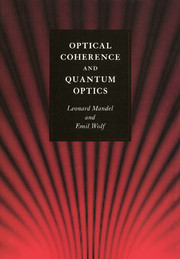Book contents
- Frontmatter
- Contents
- Preface
- 1 Elements of probability theory
- 2 Random (or stochastic) processes
- 3 Some useful mathematical techniques
- 4 Second-order coherence theory of scalar wavefields
- 5 Radiation from sources of any state of coherence
- 6 Second-order coherence theory of vector electromagnetic fields
- 7 Some applications of second-order coherence theory
- 8 Higher-order correlations in optical fields
- 9 Semiclassical theory of photoelectric detection of light
- 10 Quantization of the free electromagnetic field
- 11 Coherent states of the electromagnetic field
- 12 Quantum correlations and photon statistics
- 13 Radiation from thermal equilibrium sources
- 14 Quantum theory of photoelectric detection of light
- 15 Interaction between light and a two-level atom
- 16 Collective atomic interactions
- 17 Some general techniques for treating interacting systems
- 18 The single-mode laser
- 19 The two-mode ring laser
- 20 The linear light amplifier
- 21 Squeezed states of light
- 22 Some quantum effects in nonlinear optics
- References
- Author index
- Subject index
14 - Quantum theory of photoelectric detection of light
Published online by Cambridge University Press: 05 April 2013
- Frontmatter
- Contents
- Preface
- 1 Elements of probability theory
- 2 Random (or stochastic) processes
- 3 Some useful mathematical techniques
- 4 Second-order coherence theory of scalar wavefields
- 5 Radiation from sources of any state of coherence
- 6 Second-order coherence theory of vector electromagnetic fields
- 7 Some applications of second-order coherence theory
- 8 Higher-order correlations in optical fields
- 9 Semiclassical theory of photoelectric detection of light
- 10 Quantization of the free electromagnetic field
- 11 Coherent states of the electromagnetic field
- 12 Quantum correlations and photon statistics
- 13 Radiation from thermal equilibrium sources
- 14 Quantum theory of photoelectric detection of light
- 15 Interaction between light and a two-level atom
- 16 Collective atomic interactions
- 17 Some general techniques for treating interacting systems
- 18 The single-mode laser
- 19 The two-mode ring laser
- 20 The linear light amplifier
- 21 Squeezed states of light
- 22 Some quantum effects in nonlinear optics
- References
- Author index
- Subject index
Summary
Interactions of a quantized electromagnetic field
In the preceding chapters we have studied the quantum properties of the electromagnetic field, but we have treated it as a free or non-interacting quantum system until now. However, both the emission and the absorption of light imply interactions with other quantum systems, and we now turn to the treatment of such interaction problems.
It is true that, to a limited extent, we have already succeeded in treating some interactions of light in previous chapters, without invoking the full apparatus of the quantum theory of interacting systems. For example, in Chapter 9 the electromagnetic field was treated as a classical potential acting on an atomic quantum system, and in Sections 12.2 and 12.9 we invoked simple heuristic arguments to describe the operation of certain optical detectors. But these are limited applications, and, in any case, the validity of results obtained in this way needs to be confirmed.
To describe the state of a quantized electromagnetic field (F) in interaction with some other quantum system (A), we evidently require an enlarged, or product Hilbert space, which encompasses both F and A, of which the Hilbert spaces of F and A are subspaces. We shall find it convenient to refer to the other system A as an ‘atomic system’, simply to give a name, without restricting the nature of A. The dynamical variables of the field ÔF(t) and of the atomic system ÔA(t) commute at the same time t, and at the beginning, when the interaction between them is assumed to be turned on, each operator acts only on the state vectors within its respective Hilbert space.
- Type
- Chapter
- Information
- Optical Coherence and Quantum Optics , pp. 683 - 740Publisher: Cambridge University PressPrint publication year: 1995



